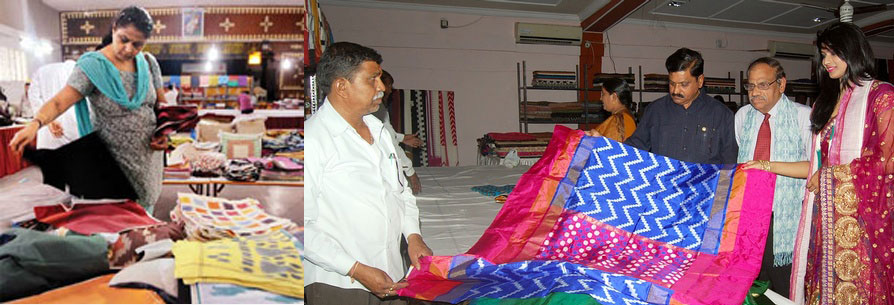Pochampally weavers knit success story

You'd have heard of how traditional handloom weavers are losing out to industrialisation and struggling to keep pace with the changing markets and demand. But this story is different. This is about how weavers in and around Pochampally village got together to save their traditional weave, handmade Pochampally Ikat, from a slow death.
Pochampally Ikat is the turf of weavers from around 22 villages, including Pochampally, in the Telangana region. The textile technique involves making patterns by tying and dyeing the yarn prior to weaving. This unique process, quite labour intensive, gives their Ikat fabrics a distinct identity. The popularity of the designs has had large-scale manufactures copying them in the mechanised looms and mass producing them at much lower prices.
This was quite a death blow to the traditional weavers, who could no longer factor in the costs of yarn and colours, processing workers' fees and the weavers' wages to their produce if they had to stay competitive in market.
In dire straits, the weavers had to think out of the box. That is how 33 of them decided to turn entrepreneurs. They approached the Andhra Pradesh government for help to set up a large-scale Pochampally handloom unit at Kanumukkala, about 60 kilometres fromHyderabad — a location central to the 22 weaving villages.
Anjaiah K narrates how they struggled to convince the authorities to get a loan and open the Pochampally Handloom Park in 2007. He is in Bangalore as part of a Pochampally Ikat exhibition.
Their venture now employs 380 people, all from the weaving community. Most of them, expert weavers, take on other roles as well, from marketing to selling. None of them studied beyond Class X. "We set up 500 looms but started working with about 350. The government loan covered the building and infrastructure costs, but the working capital had to come from us," Anjaiah recalls. The going is still tough after six years. "We can only make about 7 sarees with one warp (In weaving cloth, the warp is the set of lengthwise yarns that are held in tension on a loom). On average, it takes a weaver about four days to make one saree. Before that, three people work with the yarn, design and colours for about 20 days to get it ready to be weaved," he says.
Initially, they struggled to pay weekly wages to all the weavers. They, then, reduced the number of active looms to 120. They also had to adopt multi-marketing strategies, including exhibitions in different cities, to sell their products — sarees, dress materials, curtains, bedspreads, etc. "Our silk sarees are priced between Rs 3,000 and Rs 12,500.
That just about covers the cost of yarn, colours, processing and weaving," says Sahesh S, a weaver in charge of marketing. An exhibition costs them about Rs 2,00,000. "We are asking the government for more help," he says.
The demand for specialty, handmade fabrics is definitely growing. These traditional weavers-turned-entrepreneurs are still struggling to balance demand and supply but are determined not to give up before the odds.

